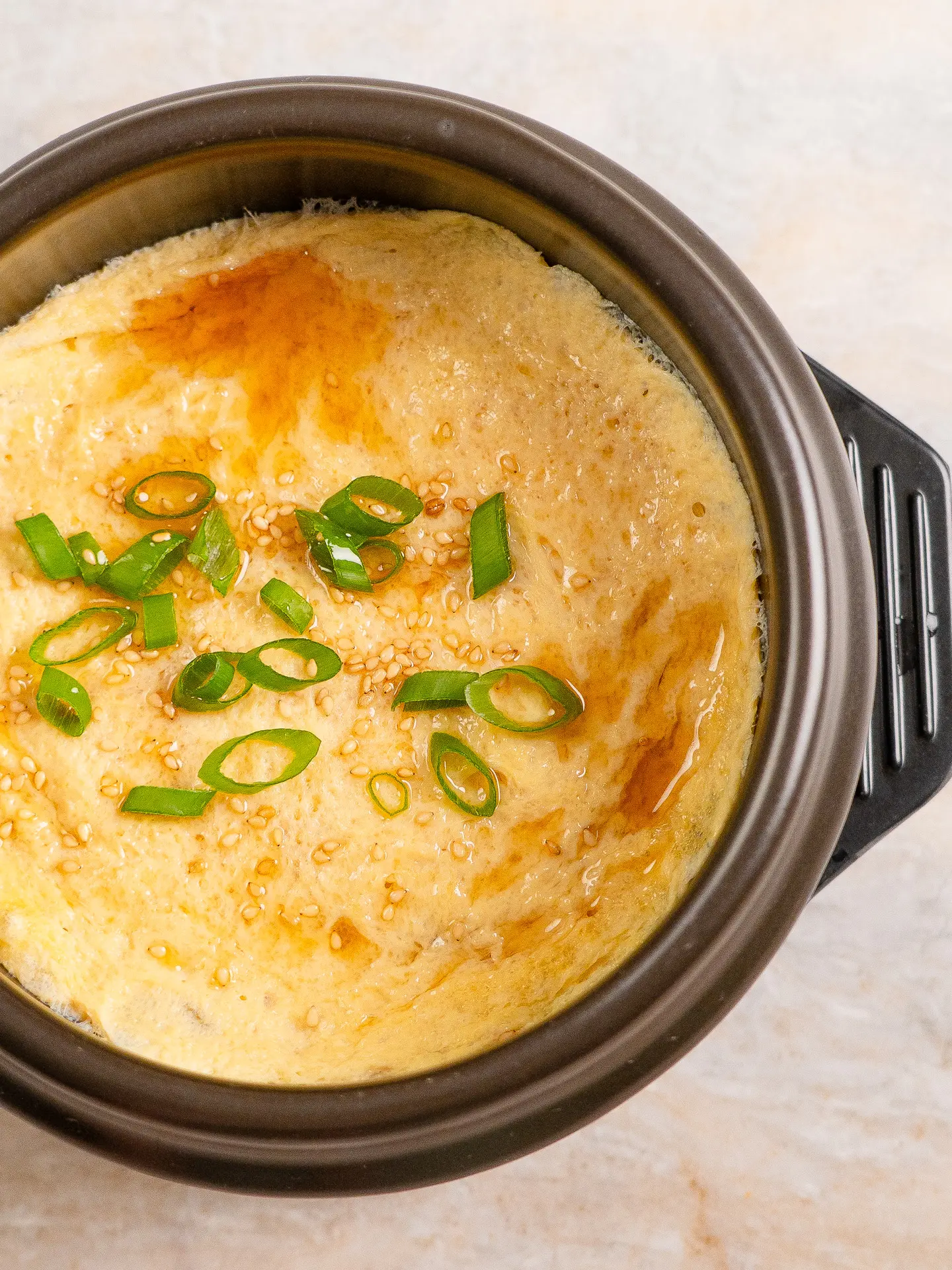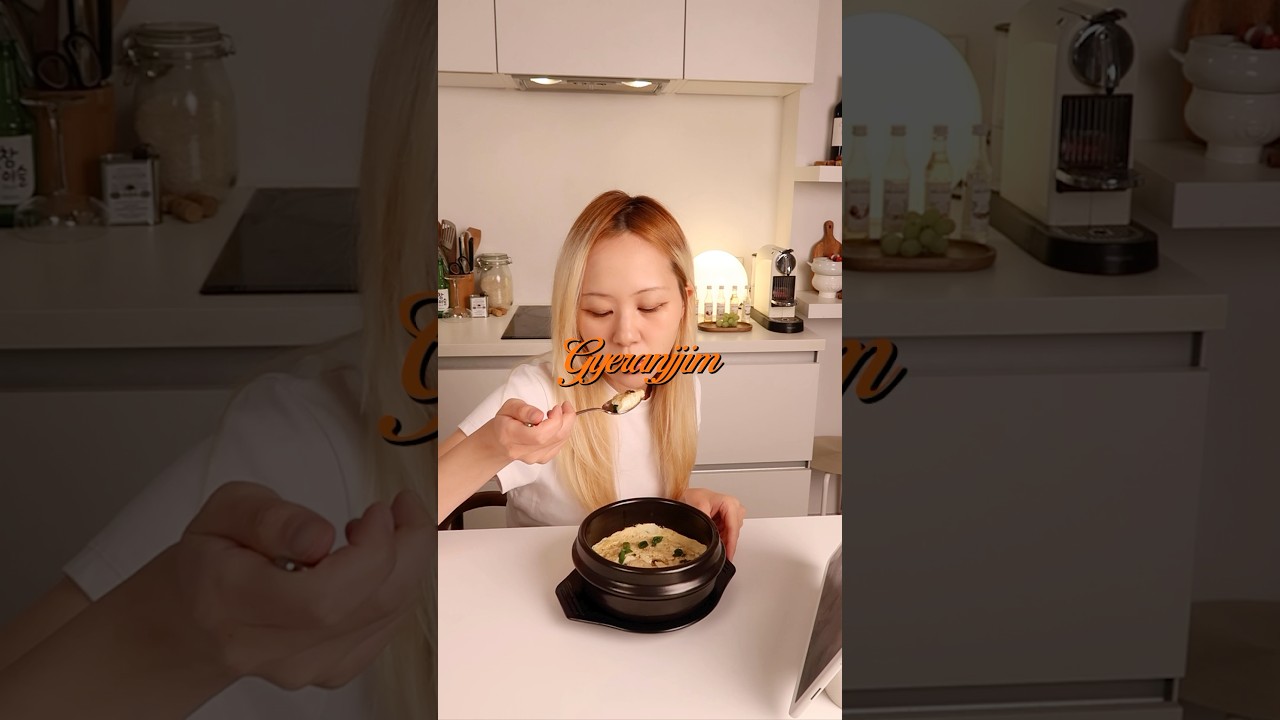Today I’m going to show you the easiest Korean Steamed Eggs recipe you can make in just 5 minutes using a microwave. You don’t even need to turn on the stove – all you need is some eggs!
Even though it’s super simple, it tastes just like the rich, homemade gyeranjjim(계란찜) my mom used to make in a ttukbaegi over the stove.
Table of Contents
Ingredients for Steamed Eggs
The ingredients for Korean steamed eggs are incredibly simple. You only need eggs, water, and a pinch of salt to make it. For extra umami flavor, you can add fish sauce or salted shrimp. At restaurants, it’s common to enhance the flavor with MSG or Dashida (Korean soup stock powder). Optional toppings like green onions or carrots can be added, and a drizzle of sesame oil is usually poured on top to finish.
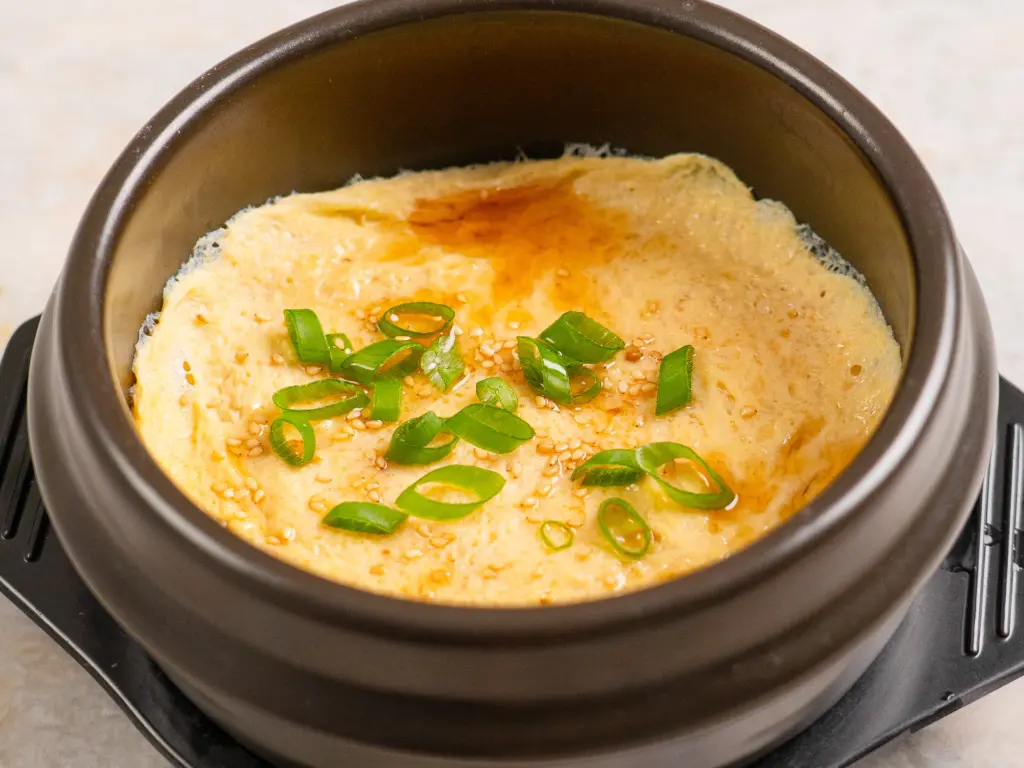
Different Recipes of Korean Steamed Eggs
In Korea, there are several ways to make gyeranjjim.
- Microwave: This is the method I’ll show you today. It’s the simplest, quickest way — steaming the egg mixture in the microwave.
- Rice Cooker: You can place a bowl of egg mixture on top of the rice before cooking it in the rice cooker. That way, you can make both steamed rice and steamed eggs at the same time! My mom often used this method at home.
- Gas Stove: This is the most traditional method. The egg mixture is cooked directly over a flame in a ttukbaegi (Korean earthenware pot). The fluffy Korean steamed eggs you often see at Korean restaurants are made this way.
- Steamer: You can also steam it using a steamer basket. This method creates an ultra-smooth, pudding-like texture. It’s commonly used for large batches, like in school cafeterias or catering kitchens.
Differences Between Korean, Japanese, and Chinese Steamed Eggs
Just like Japan and China have their own versions of steamed eggs, many Asian countries have developed their own unique styles of this dish.
- Korean Steamed Eggs (Gyeranjjim)
Steamed eggs in Korea are fluffy and soft, but slightly rougher in texture than the silky Japanese version – but still tender and light. Eggs are mixed with water (or broth) and seasoned with fish sauce, soy sauce, or salt. The mixture is steamed in a ttukbaegi (Korean clay pot). It’s common to add toppings such as green onions, carrots, and a drizzle of sesame oil.
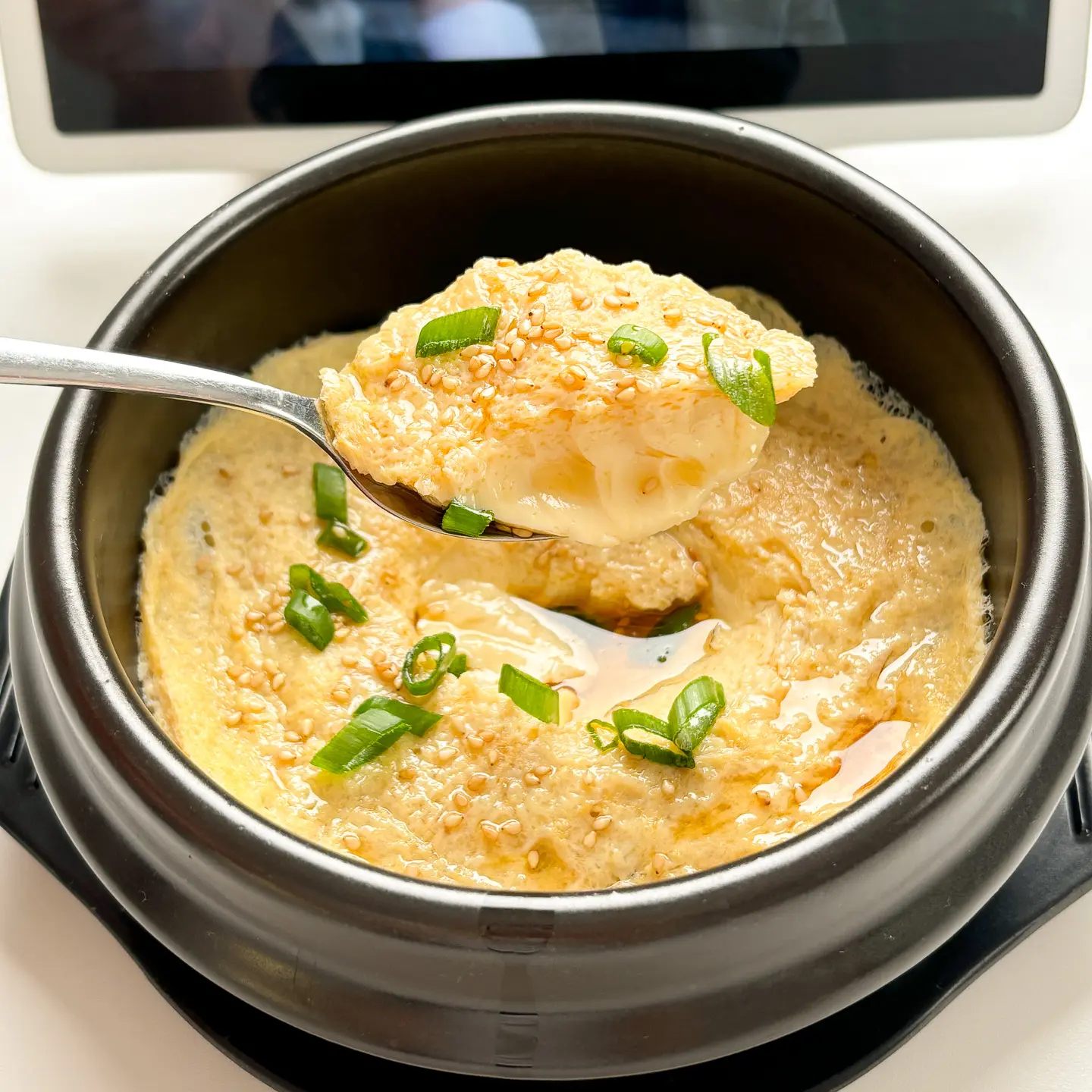
- Japanese Steamed Eggs (Chawanmushi)
Japanese steamed eggs has an extremely silky, pudding-like texture that melts in your mouth. The egg mixture is strained through a fine sieve for an ultra-smooth texture, then combined with dashi stock (made from kombu or bonito flakes). It’s lightly seasoned with soy sauce and mirin, creating a clean and delicate flavor. The mixture is gently steamed at a low temperature to achieve its signature soft, custard-like consistency.
- Chinese Steamed Eggs
Chinese steamed eggs are also smooth, but have a slightly firmer, more bouncy texture than the Japanese version. The eggs are mixed with water, strained for smoothness, and seasoned with salt or chicken stock powder to enhance the umami flavor. They are steamed slowly over low heat, similar to a bain-marie (water bath) method. It’s common to top the finished dish with a drizzle of soy sauce, green onions, shrimp, or other toppings.
How to Make Steamed Eggs Without a Ttukbaegi?
If you’ve been putting off making Korean steamed eggs because you don’t have a ttukbaegi (Korean clay pot), today is your lucky day! With this recipe, you can easily make soft steamed eggs using just an ordinary bowl and a microwave. Just make sure you use a microwave-safe bowl.
Can You Cook Eggs in the Microwave?
Yes, you can! However, you must pierce or crack the egg yolk before microwaving it.
Otherwise, the egg could explode in the microwave – and trust me, you don’t want that to turn into a big cleanup day.
Cooking Tips
How to Make Perfect Korean Steamed Eggs (Gyeran-jjim)
- Get the Egg-to-Water Ratio Right: If the ratio is off, the eggs can turn out too hard or too watery. A good rule of thumb is 1:1.5 to 1:2 (egg:water).
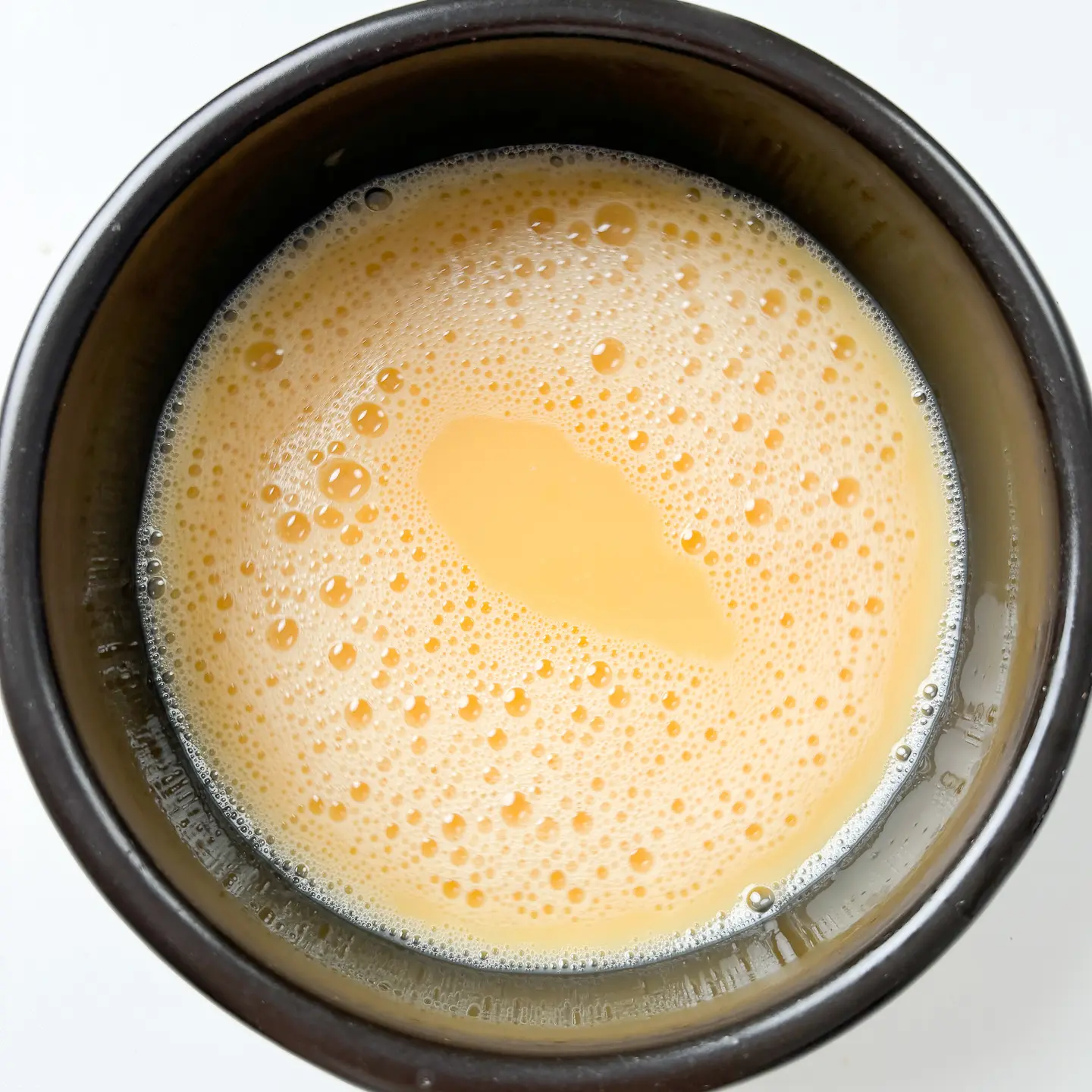
- Beat the Eggs Thoroughly: Make sure the eggs are well beaten until smooth. This helps create a softer, more even texture.
- Cover While Microwaving: To prevent the eggs from drying out, cover the bowl with a plate or plastic wrap (poke a few small holes). The steam trapped inside will gently cook the eggs. If you don’t cover it, the surface can dry out and wrinkle.
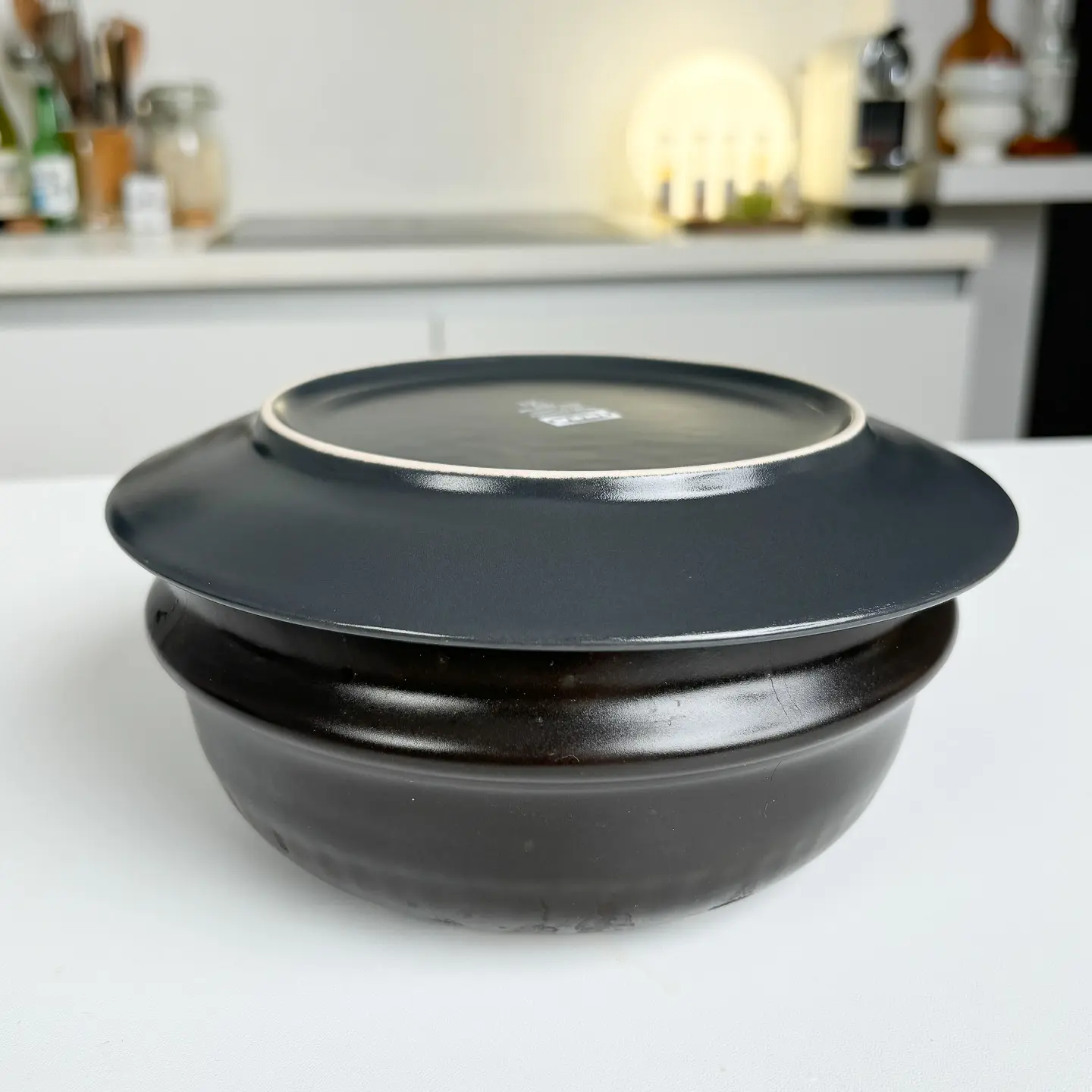
- Adjust Microwave Power: Based on 600W, steam the eggs for about 5 minutes. If your microwave is 700W, reduce the time to around 4–4.5 minutes and check for doneness as you go.
- Avoid Overcooking at High Power: If the microwave power is too strong, the eggs can dry out or turn slightly gray. Don’t worry if the color changes a little — it will still taste delicious!
- Check for Doneness: Insert a chopstick or wooden skewer into the center. If it comes out clean without any raw egg, your gyeranjjim is ready!
How to Make Even Softer Steamed Eggs
If you want your gyeran-jjim to be even softer and smoother, try this tip: After beating the eggs well, strain the mixture through a fine-mesh sieve. This will remove the stringy parts of the egg and give you a nice silky texture.
For an even easier method, you can blend the eggs in a blender instead of beating them by hand. Blending creates a super smooth mixture and you can skip the straining step altogether!
How to Steam in the Microwave
In Korea, it’s common to steam foods using the microwave. The key to steaming in the microwave is trapping the steam to keep the moisture in. You can loosely cover the bowl with a lid or wrap it with plastic wrap, then poke a few small holes. This allows minimal steam to escape while keeping the dish moist and tender.
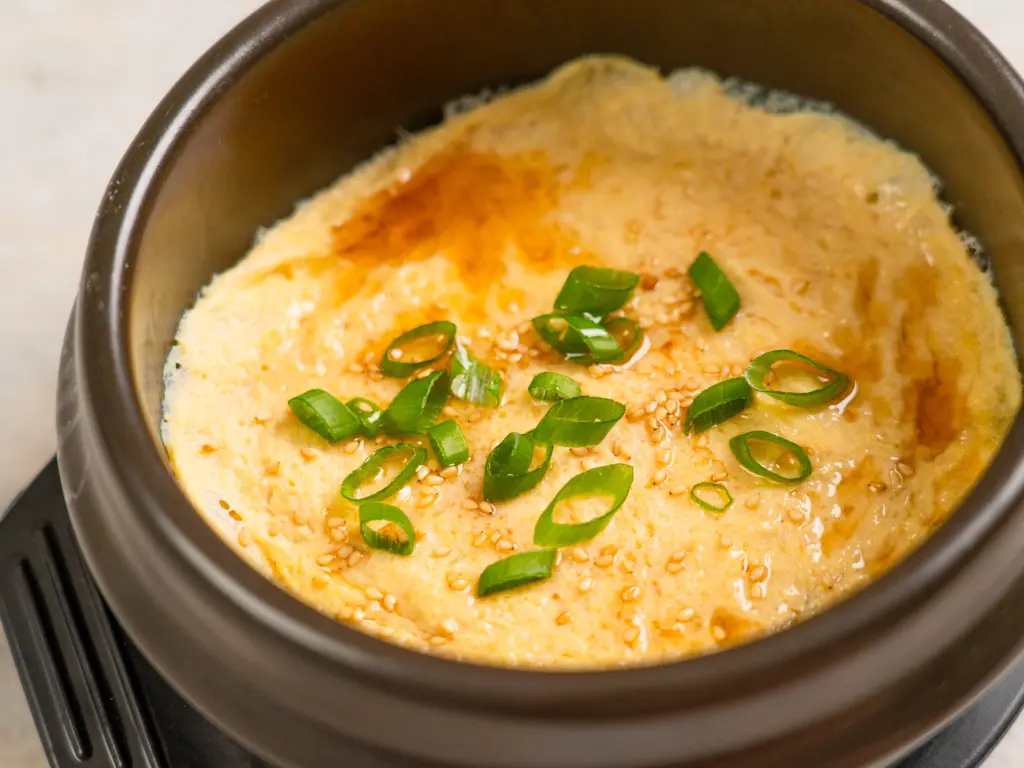
Various Korean Egg Recipes
In the past, meat was extremely rare in Korea. Because Korea was an agrarian society, cows were primarily used for agriculture and could not be easily consumed as food. To supplement protein, people relied heavily on more affordable ingredients like eggs and beans. That’s one of the reasons why there are so many creative Korean egg recipes today. Let’s take a look at some of the most popular!
Ganjang Gyeran Bap (Soy Sauce Egg Rice)
This dish is made by placing a fried egg over a bowl of rice, then drizzling it with soy sauce and sesame oil.
In Korea, it’s considered true comfort food — something almost every Korean grew up eating, especially for breakfast.

Here’s a 2-minute microwave recipe for Ganjang Gyeran Bap that has been viewed by over a million people. It’s incredibly simple and delicious — highly recommended for those lazy days when you don’t feel like cooking.
Mayak Eggs (Soy-Marinated Soft-Boiled Eggs)
Many non-Koreans are familiar with this trendy side dish. Originally, Korea didn’t have “mayak eggs” — instead, we had a traditional soy-braised eggs called gyeran-jorim. Mayak eggs are a newer creation where soft-boiled eggs are marinated in soy sauce. They are soft, savory, and absolutely addictive when served over rice. In Korean, “밥도둑 (bapdoduk)” means “rice thief,” a nickname given to dishes so delicious that they make you keep stealing bites of rice — and mayak eggs are a perfect example!
Gyeran Mari (Korean Rolled Omelette)
This is a rolled egg dish cooked in a frying pan. Vegetables like carrots or scallions are often added, and sometimes even seaweed. Nowadays, younger people like to add mozzarella cheese for a gooey twist. It’s also a popular item for drinking snacks.
Korean Street Toast (Gilgeori Toast)
You might already know this one! Korean street toast (Gilgeori Toast) is made by mixing shredded cabbage into an egg mixture, frying it up, and placing it between slices of bread. It’s topped generously with sugar and ketchup, creating a unique sweet-and-savory flavor. This nostalgic street food has become beloved both in Korea and abroad.
How to Eat Korean Steamed Eggs
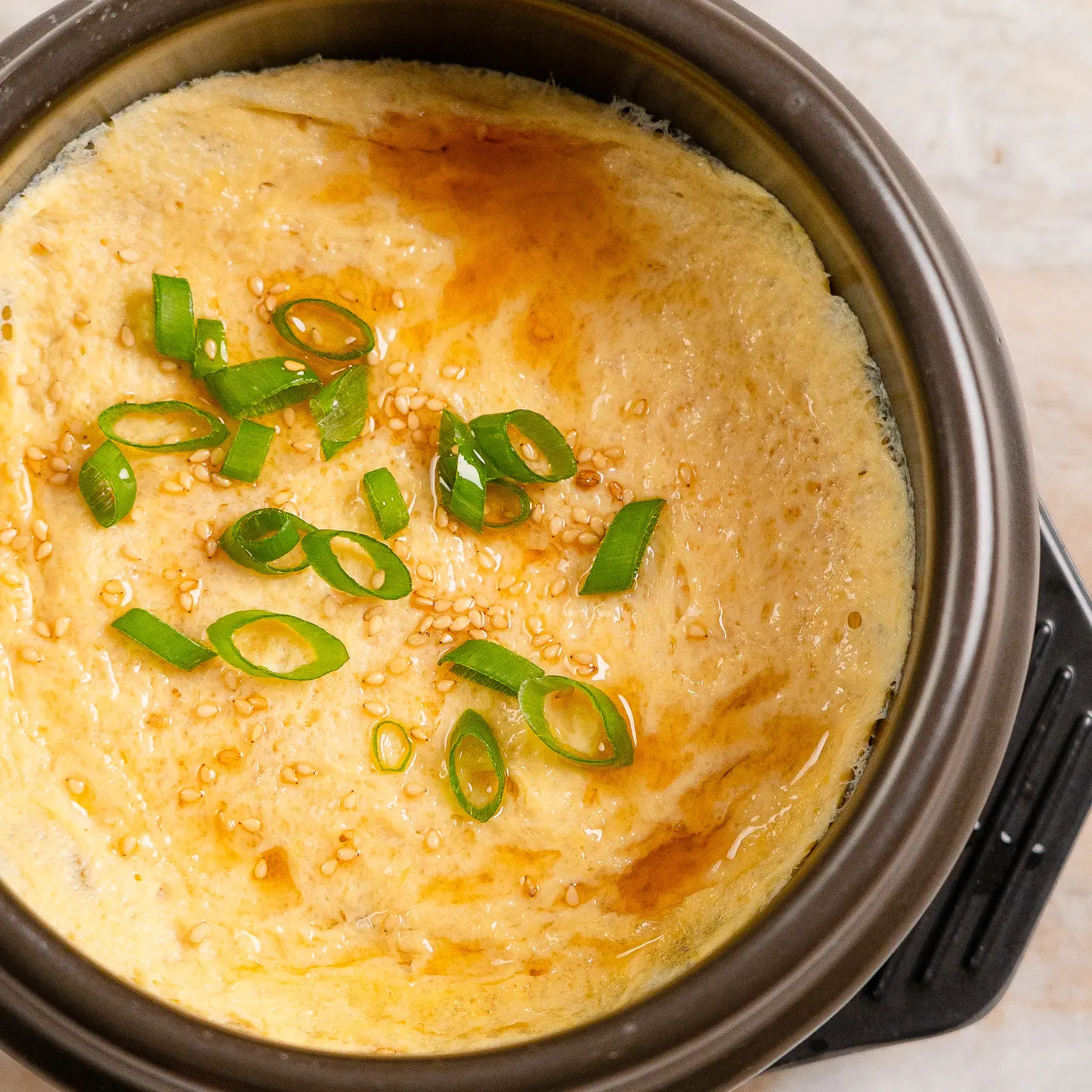
In Korea, gyeranjjim (steamed eggs) is typically enjoyed as a side dish alongside a bowl of rice.
It’s a popular breakfast menu because it’s warm, soft, and easy to eat, making it perfect for a gentle start to the day. At dinner, it’s often served with other main dishes as part of a larger meal.
That said, you can also enjoy gyeranjjim on its own, just like a Western-style omelet.
There are no strict rules — it’s delicious either way!
Foods That Pair Well with Gyeranjjim
- Korean BBQ: Gyeranjjim goes perfectly with Korean BBQ. If you visit Korean BBQ restaurants, you’ll often find a small bowl of steamed eggs served as one of the complimentary side dishes. The soft, savory eggs balance out the richness of the grilled meat beautifully.
- Spicy Food: Koreans also love pairing gyeranjjim with super spicy dishes like dakbal (spicy chicken feet) or super spicy tteokbokki like Yeopgi Tteokbokki.

Here’s an authentic Seoul restaurant-style Rosé Tteokbokki recipe. If you find tteokbokki a little too spicy, I highly recommend making gyeranjjim alongside it for the perfect balance!
Ingredient Substitutes
Tuna Sauce (Chamchi-aek)
If you don’t have tuna sauce, you can use other types of fish sauce like anchovy sauce, or even salted shrimp (saeujeot). If none of these are available, you can simply skip it and add a little more salt to taste.
However, keep in mind that you’ll lose some of the deep umami flavor. If you want to boost umami without fish sauce, you can also add a little bit of Dashida (Korean soup stock powder) or MSG instead.
Ttukbaegi (Korean earthenware pot)
If you don’t have a ttukbaegi, no worries! You can simply use any microwave-safe bowl instead.
Is Gyeranjjim Healthy?
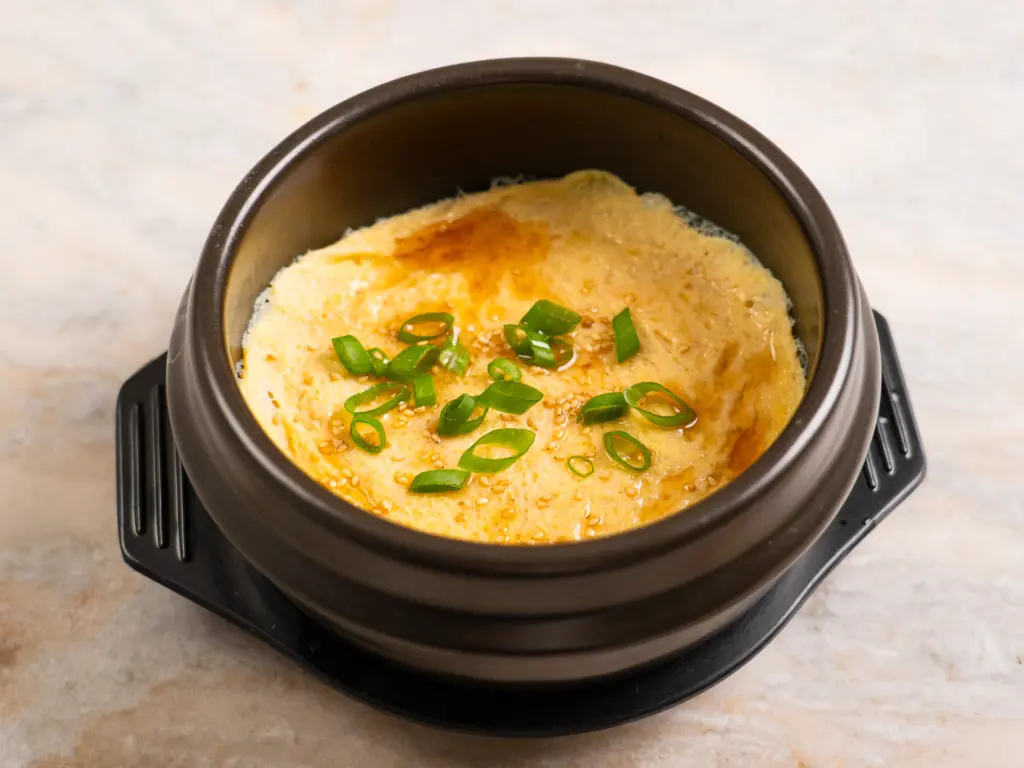
Absolutely! Gyeran jjim is packed with protein — you can almost think of it as “steamed protein.” It’s also rich in vitamin A and B vitamins.
Since it’s warm, soft, and easy to digest, it’s a perfect dish for when you’re feeling under the weather or just want something gentle and comforting.
Get Ingredients
- Earthenware Pot (Ttukbaegi): https://amzn.to/4lgtPKm (US), https://amzn.to/4hWscyH (DE), https://amzn.to/3QYfftl (BE, NL), https://amzn.to/4cwh5vx (UK)
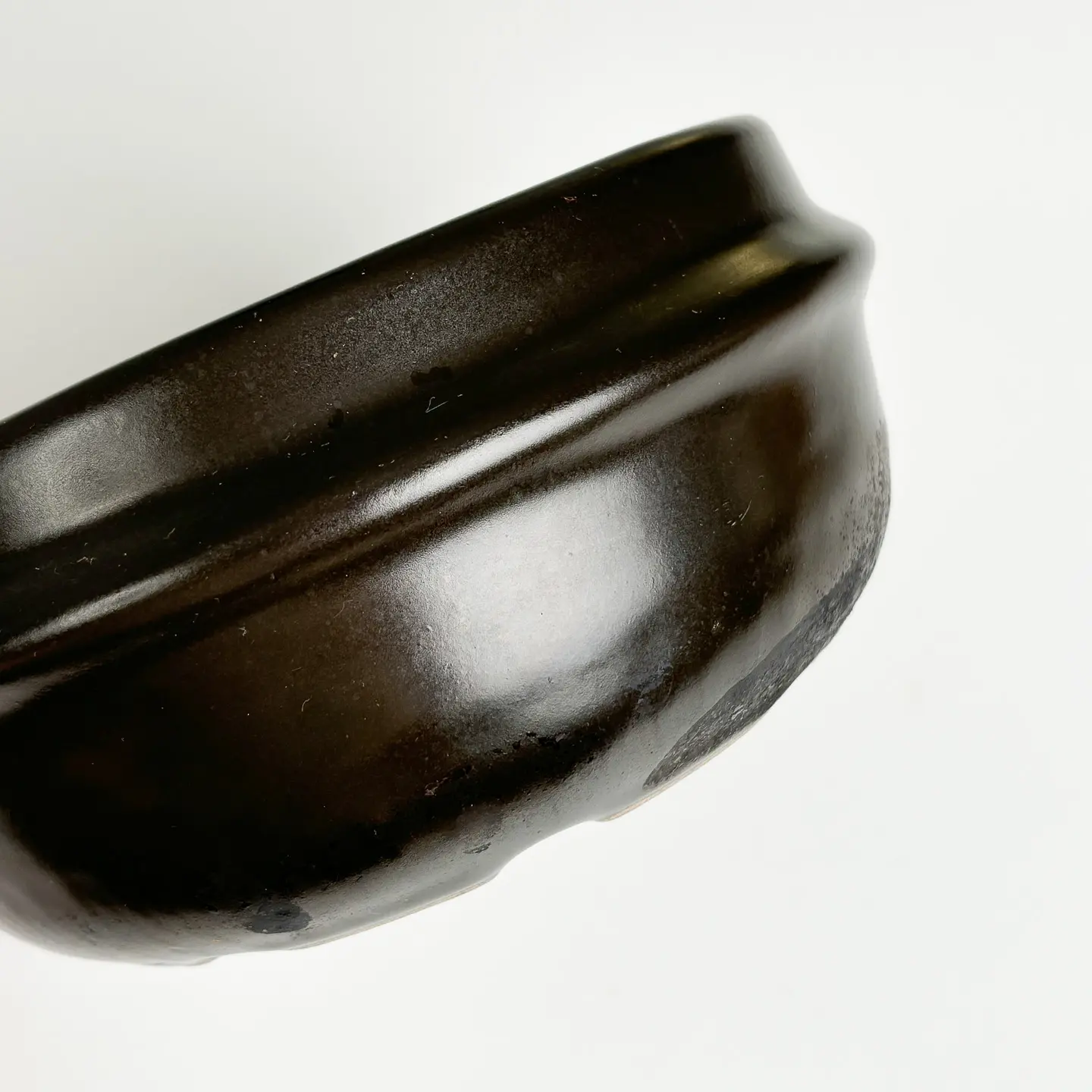
- Kitchen Scissors: easy to cut ingredients like spring onions here without using a knife and cutting board. https://amzn.to/4crbPcw (US), https://amzn.to/43IM4Cd (DE), https://amzn.to/3FS0Ix0 (BE, NL), https://amzn.to/4jvayn6 (UK)
- Tuna Fish Sauce: https://amzn.to/42Bxrjn (US)
- Anchovy Fish Sauce: https://amzn.to/3EsYZ0c (US)
- Dashida: https://amzn.to/4iyh9gb (US), https://amzn.to/42AKP5y (UK), https://amzn.to/41PSmNz (NL), https://amzn.to/3RaARTg (DE)
- Sesame seeds: https://amzn.to/3D85aXg (US), https://amzn.to/3EQVBwt (DE), https://amzn.to/3D7C6iD (NL, BE), https://amzn.to/4i6V8UL (UK)
- Sesame oil: https://amzn.to/3QCZIyE (US), https://amzn.to/43fg5cn (DE), https://amzn.to/4bdP8Ys (NL)
Disclosure: Blonde Kimchi is part of the Amazon Services LLC Associates Program, an affiliate advertising program that allows websites to earn advertising fees by linking to Amazon.com and promoting products.
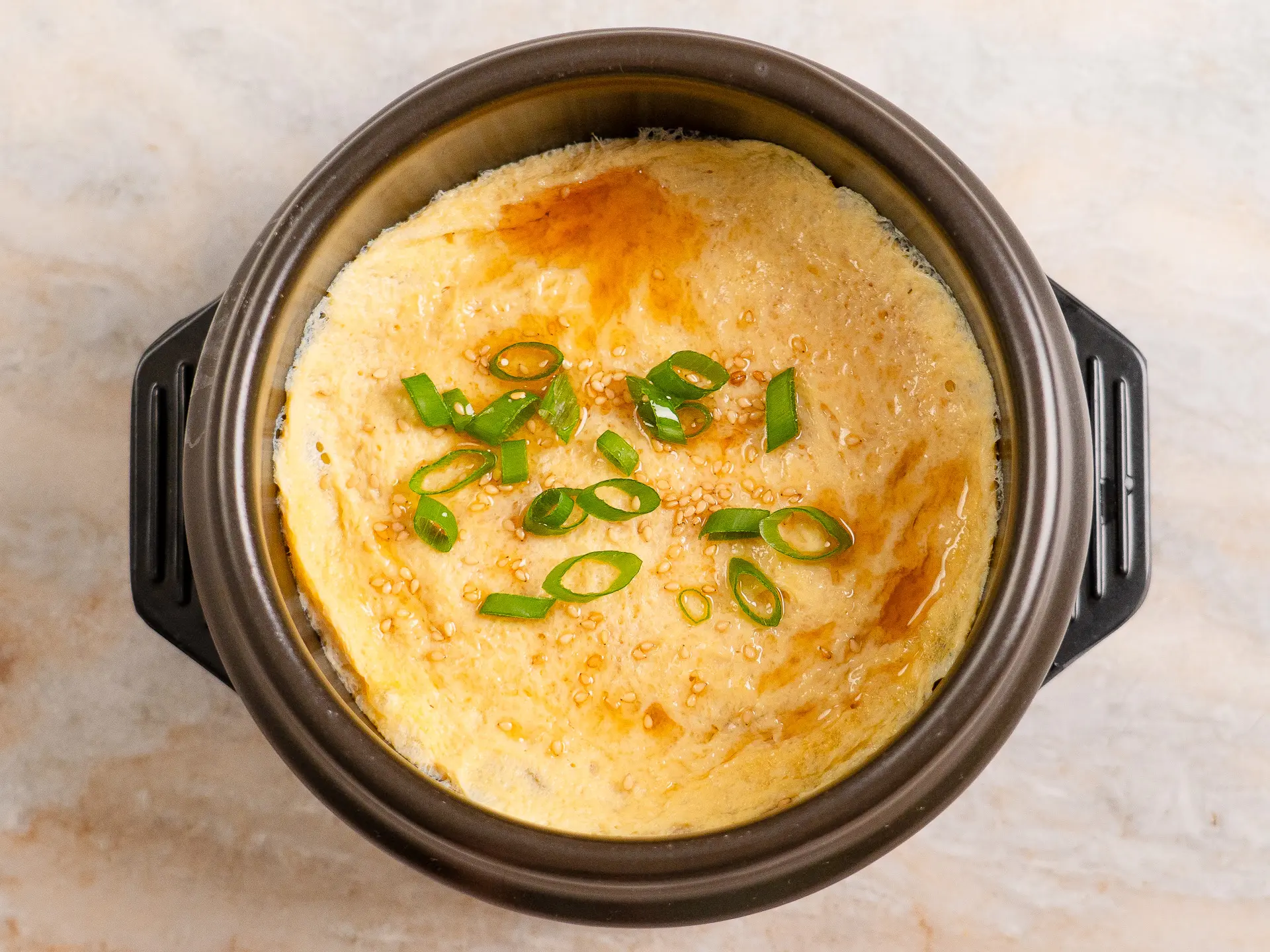
5 Minute Microwave Korean Steamed Eggs – Easiest Gyeranjjim Recipe
Ingredients
- 3 eggs
- 180 ml water
- 1 tbsp tuna sauce (tuna extract, check substitutes above on the blog post)
- 1 pinch salt (you can skip, as your preference)
- 5 g green onion (for garnish)
- 1 tbsp sesame oil
- 1 pinch sesame seeds
Equipment
Method
- Thinly slice the green part of the green onion for garnish.
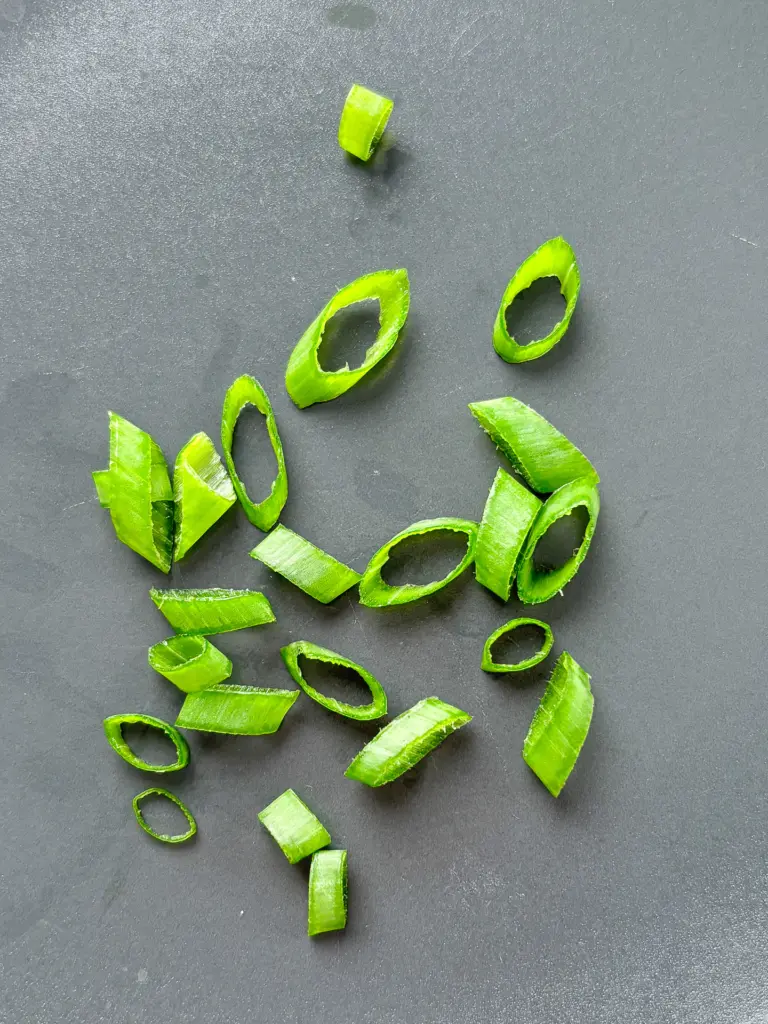
- In a microwave-safe earthenware bowl (ttukbaegi) or any microwave-safe bowl, beat 3 eggs well.
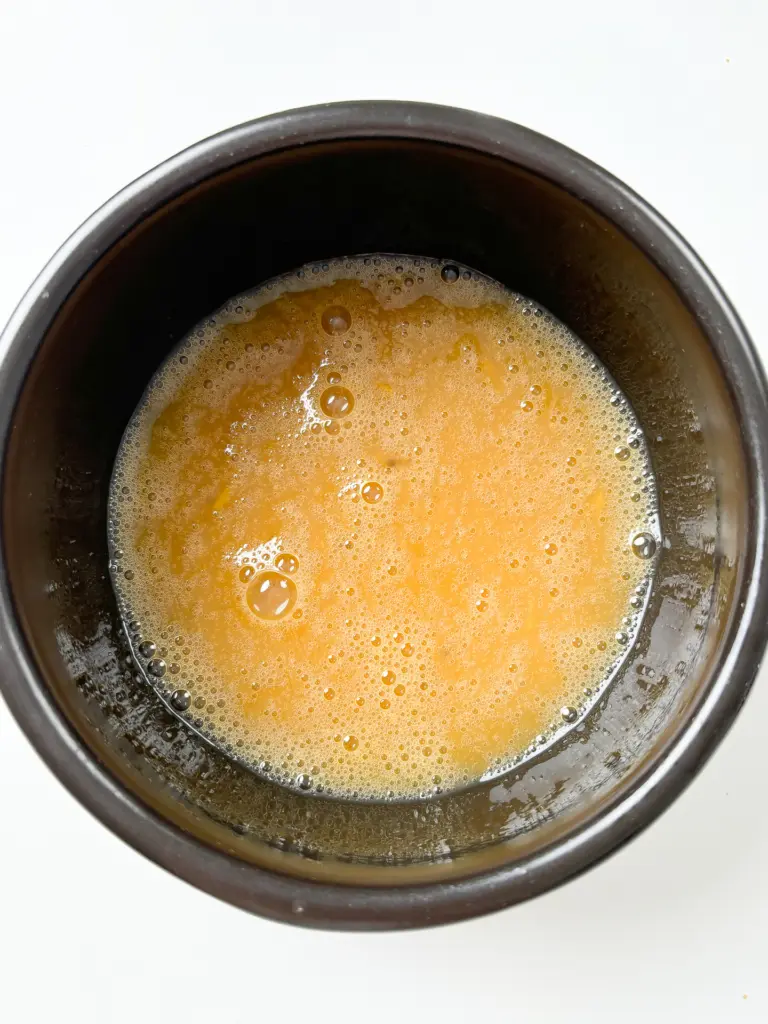
- Add 1 tablespoon of tuna sauce and mix. If you want a slightly saltier taste, add a pinch of salt (optional).
- Pour in 180ml of water and stir to combine.
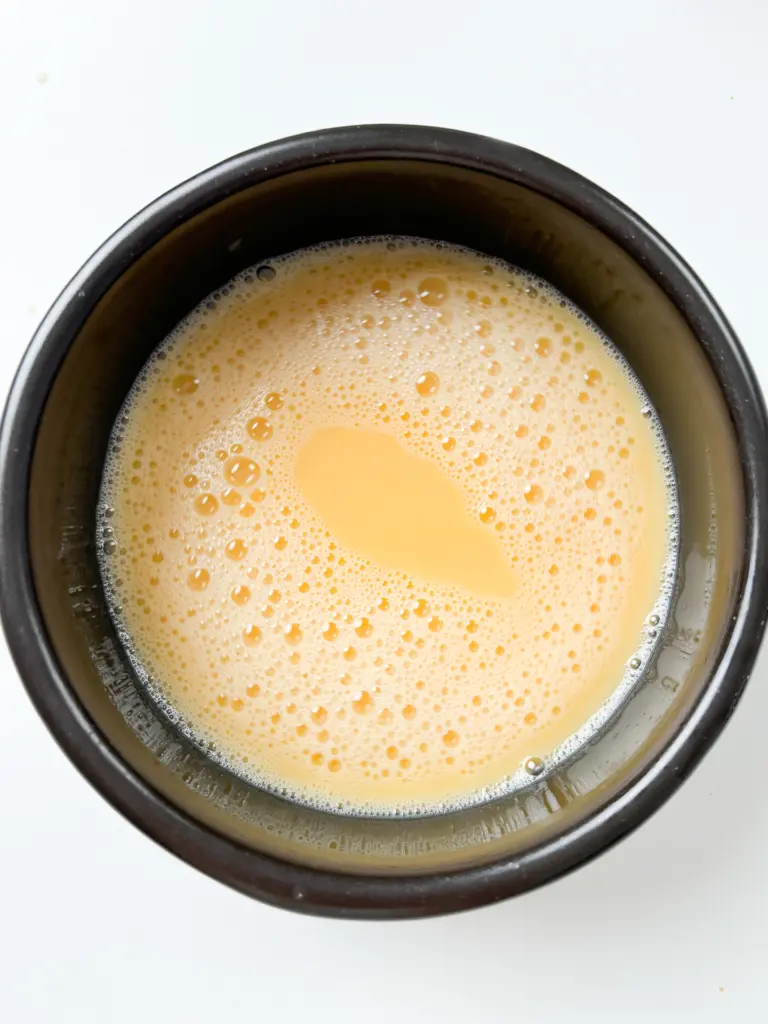
- Cover the bowl with a plate and microwave at 600W for 5 minutes.
- Check by inserting a chopstick; if no raw egg sticks, it’s done.
- Top with green onion slices, drizzle 1 tablespoon of sesame oil.
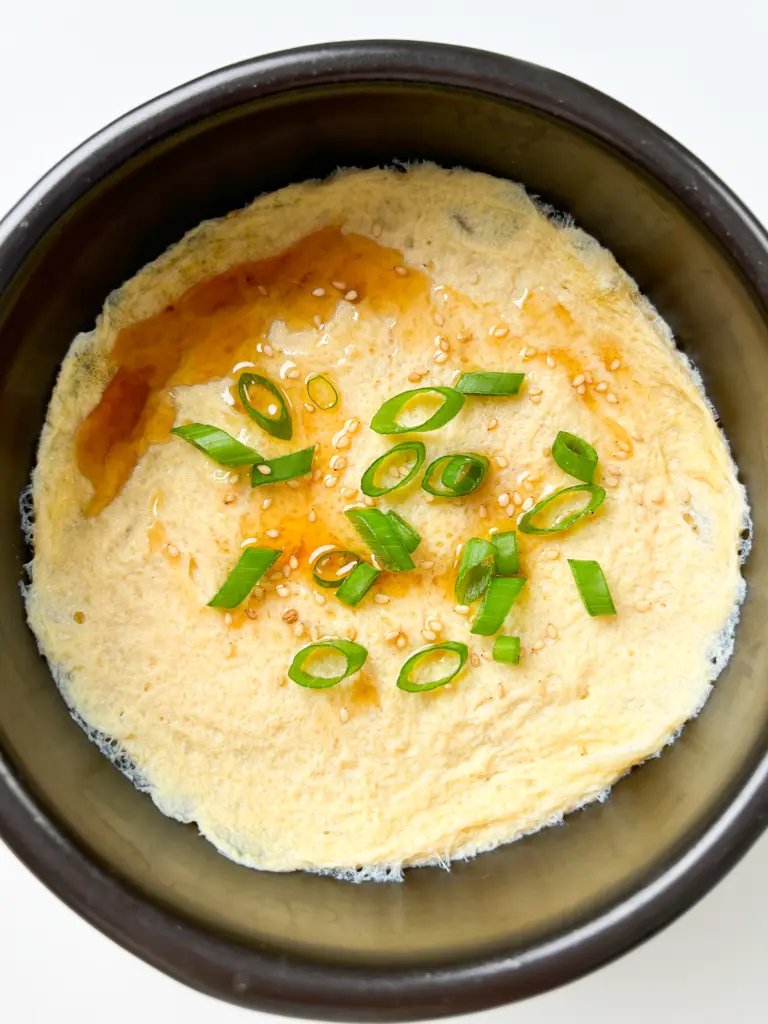
- Sprinkle with sesame seeds.
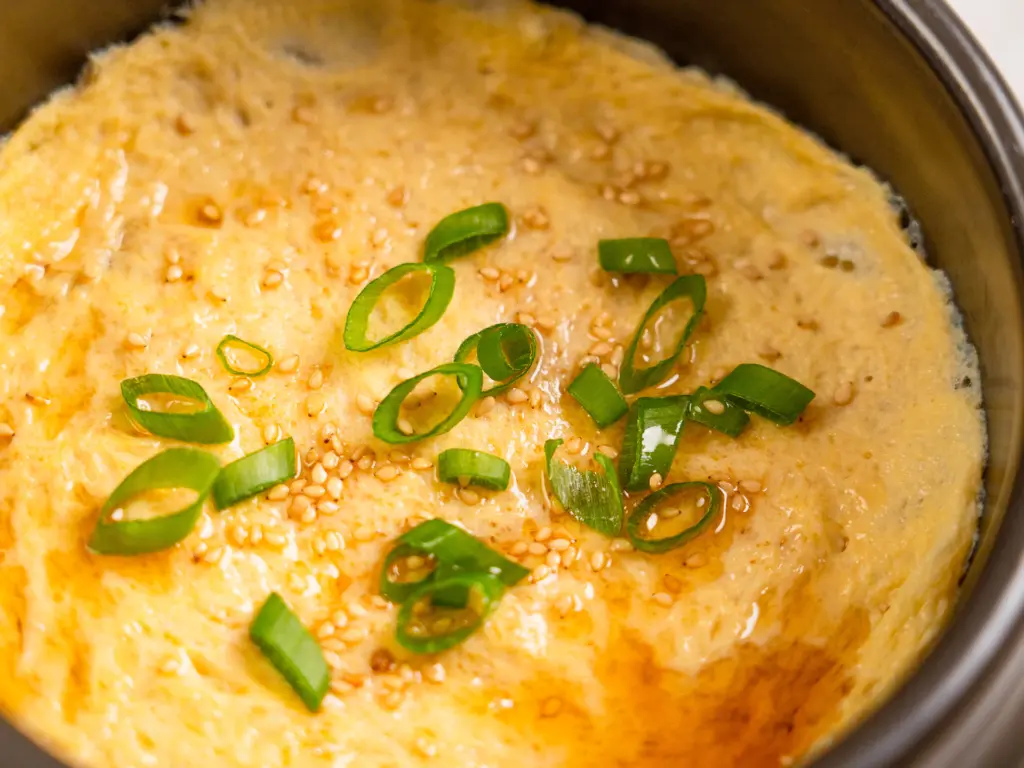
- Jal meokgetseumnida! 잘 먹겠습니다!
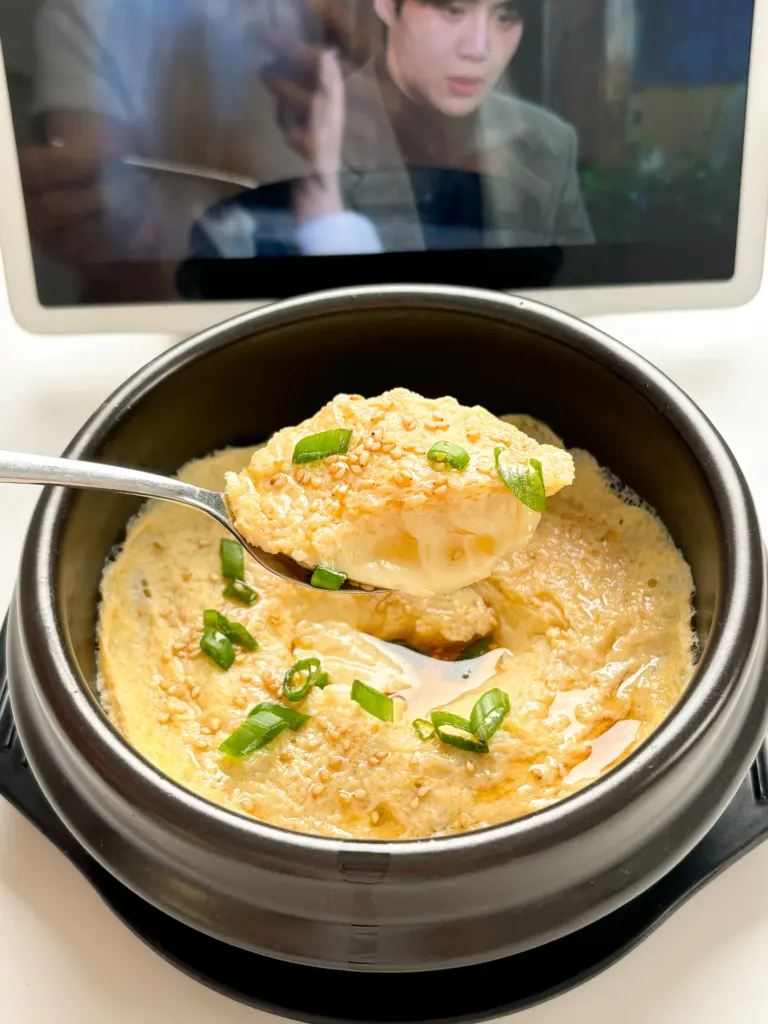
Nutritional information is an estimate. For personalized advice, consult a registered nutritionist.
